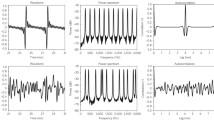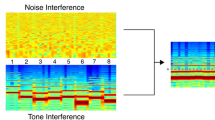Abstract
Two-tone pitch-comparison tasks typically comprise several successive pairs of successive tones separated by silent intervals. The serial occurrence of such pairs has been associated with degraded task performance, but the nature of this association is not fully understood. Human adult participants were presented with successive pairs of successive tones. The latter, to-be-compared tone of a pair could differ from the former, to-be-remembered tone of 1046.5 Hz by no more than ±15 Hz (25 cents). The direction of this difference was easier to identify when it was opposite to that of the preceding pair than when being the same. Merely responding accordingly (irrespectively of whether the response was correct or not) was found not to account for this finding. Our study demonstrates proactive interference in a two-tone pitch comparison task as the difficulty to remember when the first tone of the present pair occurred relative to the last tone of the immediately preceding pair.



Similar content being viewed by others
References
Anourova, I., Rämä, P., Koivusalo, S., Alho, K., & Carlson, S. (1999). Dissociation between auditory information processing of location and pitch. NeuroReport, 10, 3543–3547.
Baddeley, A. D. (1976). The psychology of memory. New York: Basic Books.
Cowan, N., Saults, J. S., & Nugent, L. D. (1997). The role of absolute and relative amounts of time in forgetting within immediate memory: The case of tone–pitch comparisons. Psychonomic Bulletin & Review, 4, 393–397.
Deutsch, D. (1972). Mapping of interactions in the pitch memory store. Science, 175, 1020–1022.
Deutsch, D. (1984). Memory for nonverbal auditory information: A link between behavioral and physiological studies. In: L. R. Squire & N. Butters (Eds.) Neuropsychology of memory (pp. 45–54). New York: Guilford Press.
Giangrande, J., Tuller, B., & Kelso, J. A. S. (2003). Perceptual dynamics of circular pitch. Music Perception, 20, 241–263.
Jarvik, M. E. (1946). Probability discrimination and the gambler’s fallacy in guessing. American Psychologist, 1, 453–454.
Keller T. A., Cowan N., & Saults J. S. (1995). Can auditory memory for tone pitch be rehearsed? Journal of Experimental Psychology: Learning, Memory, and Cognition, 21, 635–645.
Keppel, G., & Underwood, B. J. (1962). Proactive inhibition in short-term retention of single items. Journal of Verbal Learning & Behavior, 1, 153–161.
McGeoch, J. A. (1932). Forgetting and the law of disuse. Psychological Review, 39, 352–370.
Näätänen, R., & Picton, T. (1987). The N1 wave of the human electric and magnetic response to sound: a review and an analysis of the component structure. Psychophysiology, 24, 375–425.
Näätänen, R., Tervaniemi, M., Sussman, E., Paavilainen, P., & Winkler, I. (2001). ‘Primitive intelligence’ in the auditory cortex. Trends in Neurosciences, 24, 283–288.
Ruusuvirta, T. (2000). Proactive interference of a sequence of tones in a two-tone pitch comparison task. Psychonomic Bulletin & Review, 7, 327–331.
Ryan, J. (1969). Grouping and short-term memory: Different means and patterns of grouping. Quarterly Journal of Experimental Psychology, 21, 137–147.
Saarinen, J., Paavilainen, P., Schröger, E., Tervaniemi, M., & Näätänen, R. (1992). Representation of abstract attributes of auditory stimuli in human brain. NeuroReport, 3, 1149–1151.
Tervaniemi, M., Maury, S., & Naatanen, R. (1994). Neural representations of abstract stimulus features in the human brain as reflected by the mismatch negativity. Neuroreport, 5, 844–846.
Acknowledgments
This work was supported by the Academy of Finland (73038). The authors thank Christian Kaernbach and Virpi Kalakoski for constructive comments on an earlier version of this manuscript.
Author information
Authors and Affiliations
Corresponding author
Rights and permissions
About this article
Cite this article
Ruusuvirta, T., Wikgren, J. & Astikainen, P. Proactive interference in a two-tone pitch-comparison task without additional interfering tones. Psychological Research 72, 74–78 (2008). https://doi.org/10.1007/s00426-006-0094-y
Received:
Accepted:
Published:
Issue Date:
DOI: https://doi.org/10.1007/s00426-006-0094-y




